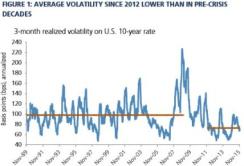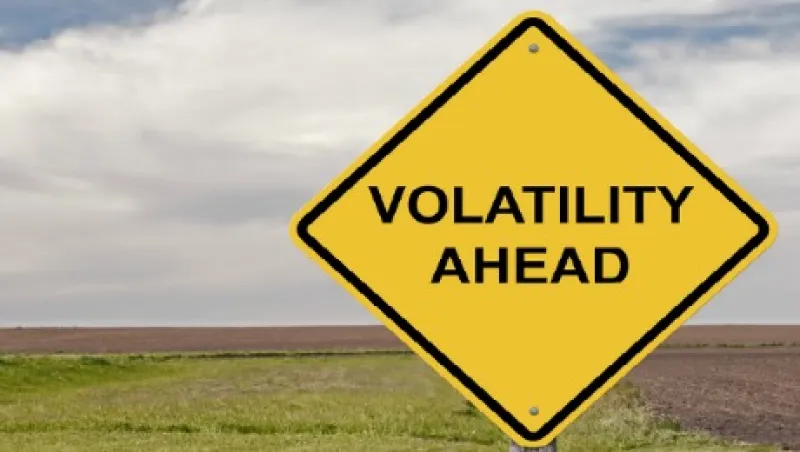The profound impact of unconventional U.S. monetary policy over the past six years — a policy rate pinned near zero, three rounds of quantitative easing — has left its mark on the economy. But has it fundamentally altered interest rate volatility?
It is true that overall U.S. volatility has diminished in recent years. Since January 2012 the average realized three-month volatility on the ten-year swap rate is 74 basis points, compared with an average of 98 basis points over the 20 years leading up to December 2008, when the federal funds rate was lowered to just above zero (see chart 1).

If the Federal Reserve struggles to raise rates further, as currently predicted by the Eurodollar options market, then the outlook for volatility could resemble what happened in Japan (see chart 2). Japanese interest rates have been hovering near zero for most of the past two decades. The average three-month realized volatility on the Japanese ten-year swap rate was 41 basis points over the past 15 years, when rates fell to near zero, versus 68 basis points during the prior ten years. With interest rates bounded by zero on the low end — at least until the recent European experience — and anemic economic growth on the high end, volatility tended to be lower as well.
To determine whether lower volatility can persist after extraordinarily accommodative monetary conditions cease, one has to expand the focus and examine the numerous drivers of interest rate volatility — many of which have undergone regime changes since 2008.
Foremost in the mind of many market participants is market liquidity or, rather, the lack thereof. Although regulations such as the 2010 Dodd-Frank Wall Street Reform and Consumer Protection Act have lowered leverage in the financial system, stricter regulation in the U.S. and Europe has resulted in more constrained balance sheets at many traditional liquidity providers, which in turn lead to higher transaction costs. Lower liquidity tends to increase day-to-day market volatility because the same-size trades now have a bigger impact on market price.
Hedge funds, which have about $2.9 trillion in total assets under management, tend to employ risk management frameworks such as value-at-risk and risk parity strategies that scale up risk under conditions of low volatility and scale down under high volatility. During large market moves, these funds would be forced to shed assets into a market that is less able to absorb them, which begets even larger market moves, particularly in risky assets. This feedback loop amplifies not only market dislocations but also the vol of vol: That is, the peak level of volatility is now higher, and the trough level of volatility is now lower.
Therefore, the continuing growth of hedge fund assets likely means lower day-to-day volatility as these trading strategies reduce risk premiums under normal market conditions. There will be not only a higher likelihood of three-standard-deviation events, but also we can expect more frequent bouts of heightened volatility like that seen this past August or during the October 2014 bond market flash crash, and yet a persistent volatility explosion on the magnitude of the 2008–’09 financial crisis is less likely. The regulation-driven lower leverage in the financial system discussed above is designed to prevent these three-standard-deviation events from morphing into catastrophic ten-standard-deviation events.
Before the 2008–’09 crisis, the mortgage community provided a structural bid to interest rate volatility to hedge its negatively convex assets (mortgage duration lengthens when rates sell off, and it contracts when rates rally). This has largely gone by the wayside, as 30 percent of outstanding mortgage-backed securities are now owned by the Federal Reserve, a noneconomic player that doesn’t hedge. Furthermore, government-sponsored enterprises such as Fannie Mae and Freddie Mac, perhaps the most significant convexity hedgers in the market precrisis, now have a much smaller footprint. This structural change in ownership of the mortgage-backed securities market has resulted in lower interest rate volatility.
In addition, global central banks now hold large portfolios of government bonds as a result of quantitative easing in developed markets and foreign currency reserve accumulation in emerging markets. This factor also dampens price movements, because reserve managers tend to do very little short-term trading.
China’s reserve selling this past August suggests that the era of continuous emerging-markets reserve accumulation may be coming to an end, however. The Fed’s holdings of mortgage and government securities will start to roll off its balance sheet in the first quarter of 2016 as the debts are retired on schedule. If the Fed gradually normalizes policy, as PIMCO expects, in the coming years, the dampening effect of central bank policy on volatility, at least in the U.S., should fade over time.
Outside of technical factors in the financial markets, economic outcomes — more specifically, the volatility of economic data such as GDP growth and inflation — are also an important determinant of interest rate volatility. PIMCO’s New Neutral thesis sees economies globally converging to modest trend growth rates. At first glance, this appears to suggest a more stable economic environment, one with smaller fluctuations. At the same time, a lower level of growth also means a higher chance of tipping into recession. Central banks, which in the New Neutral are constrained to set policy rates at levels well below those that prevailed before the crisis, have a smaller cushion for cutting rates if necessary to stabilize growth. Moreover, societal tensions over income inequality and other issues tend to escalate during times of economic hardship. The mass protests over austerity in Greece are a recent example. Elsewhere outside the U.S., slower economic growth may be even more of a concern in countries such as Venezuela and China. Meanwhile, the probability of disruptive changes to the economy is as high as ever: Think of Uber upending the taxi industry, as an example.
All these drivers of interest rate volatility — reduced liquidity, stricter regulation, growth of hedge fund assets, changing profile of market participants and the New Neutral growth environment — generally point to higher levels of uncertainty going forward. Although regulation has hopefully curtailed the likelihood of volatility explosions like what happened during the 2008–’09 financial crisis, the subsequent increased rigidity of the market structure means that we can expect more frequent gap moves. So, despite the relatively tame market environment of recent memory, U.S. interest rates are unlikely to be structurally less volatile going forward.
Vicky Zhao is a senior vice president and portfolio manager on the U.S. rates desk at Pacific Investment Management Co.’s Newport Beach, California, office.
See PIMCO’s disclaimer.






